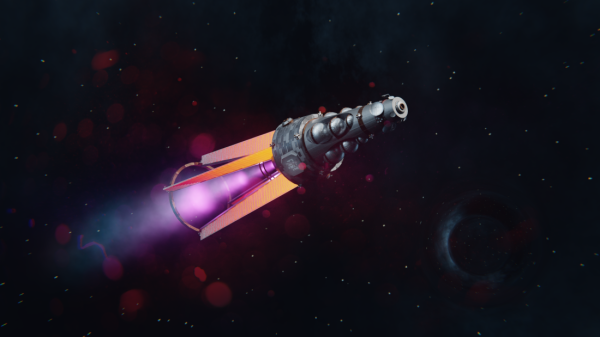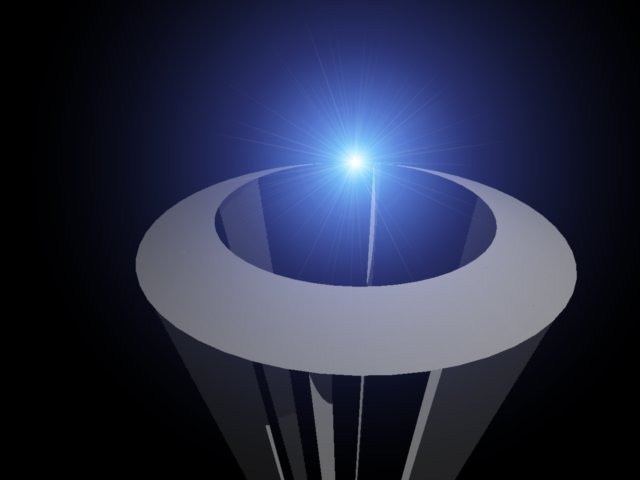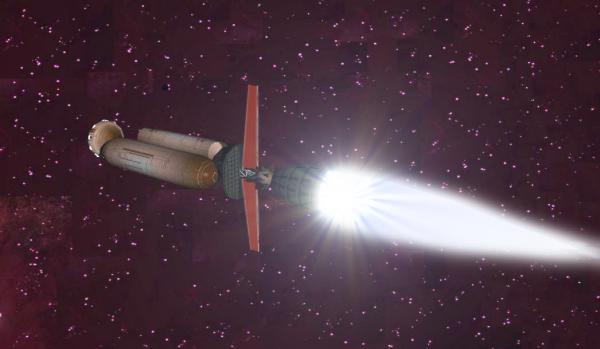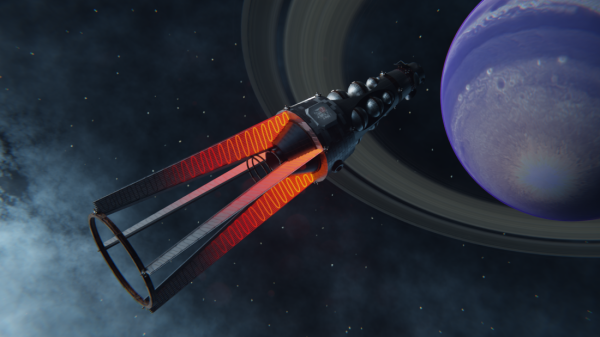BY LETTER
Torch Drives
Technology > Application > Transportation > Interplanetary Transport
Technology > Application > Transportation > Interstellar Transport
Technology > Application > Transportation > Propulsion Technology
Technology > Application > Transportation > Interstellar Transport
Technology > Application > Transportation > Propulsion Technology
External plasma drives |
 Image from Copyright Lilly Harper |
Torch Drives: An Overview
"Torch Drive" describes a class of reaction engines for spacecraft propulsion characterized by high thrust and high specific impulse, and hence very high power levels. The term is somewhat ill-defined, especially as the definition of "high thrust" and "high power" varies dramatically according to the relative technology levels of societies, but early definitions required that a Torch Ship could manage a sustained thrust of at least one centigee (0.098m/s²) with a delta-V of at least 400km/s. Modern ultratech Conversion Drive torch ships can manage accelerations and delta-V reserves a hundred or a thousand times greater.Torch drives all use high energy nuclear reactions (sustained or pulsed at a high rate) external to the spacecraft, and magnetic fields are used to deflect the resulting plasma to generate thrust. By creating the reaction outside the main structure of the spacecraft, the neutral radiation by-products of the pulse (neutrons, neutral pions, bremmstrahlung x-rays, gamma rays, and thermal radiation) can mostly escape into space, without creating a large thermal load aboard the spacecraft. This allows very high energy thrusters, which can combine both high thrust and high delta-V simultaneously.
The most common kinds of torch drives in use by terragens are Inertial Confinement Fusion, and Antimatter or Conversion Beam Core. Other systems such as Z-pinch Fusion and Nuclear Salt Water Fission have been used in the past and continue to be used in smaller numbers in some polities.
Common Design Principles
A torch drive requires one or more current carrying loops surrounding the reaction region to produce the magnetic field that deflects the plasma and charged radiation from the drive reaction. Typically, these loops are made of superconductors, since any normal conductor would quickly melt or vaporize under the high currents needed to produce the field. The field coils are backed by a high tensile strength support to withstand the magnet-current back reaction from bursting the superconductor.These field coils must be protected from the intense neutral radiation that the drive reaction produces. This is because a superconductor that becomes too hot will cease to superconduct. A common shielding design is a sheet of tungsten with a "V"-shaped cross section at a very narrow opening angle, resembling a knife-edge. The point of the V faces the radiation source, the field coil runs along the open top of the V. At very small angles of incidence, tungsten makes a good reflector of x-rays so that most x-rays are simply reflected at low angles away from the field coils and into space.
Drive technologies that produce neutrons (as most fusion reactions do, as well as fission reactions) also need to be considered. Since tungsten atoms are much heavier than neutrons, a collision between a tungsten nucleus and a neutron results in the neutron rebounding with most of its original energy, delivering only 1% of its energy on average to the tungsten shield. This scatters the neutrons away from the field coils. The narrow opening angle means that the tungsten knife edge is essentially a sheet perpendicular to the incoming radiation, allowing a large radiator area compared to the cross section exposed to the radiation.
Rates of tungsten sublimation become problematic at temperatures above 3000 K, so the shield is typically placed far enough away from the drive reaction to keep its temperature at or below this value. At all times, the shield must be kept below 3695 K, the melting point of tungsten. At these temperatures, the tungsten knife-edge sheets are radiating at a blazing yellow-white color, with the intensity of an M-class star or an old style incandescent bulb filament. A torch drive in operation appears as a brilliant flare primarily from the thermal radiation of the tungsten shields - the drive reaction itself emits relatively little visible light in comparison. With a 200:1 aspect ratio for the length of the knife blade to its width, a heat shield that absorbs 1% of the incident radiation and scatters the rest can withstand an incident intensity of 90 GW/m².
The size of the field coils is set by the requirement that the tungsten shield remain cool enough not to sublimate, and for the drive pulse fireballs not to contact the tungsten shield. Since the tungsten shield extends a considerable distance toward the detonation point (the distance from the field coil to the tip of the shield is typically 200 times or more the width of the field coil), the field coil must be set far enough back that the tip of the tungsten shield does not evaporate.
If there are multiple field coils producing the magnetic field, then the knife-blade heat shield of one coil will scatter neutrons and radiate thermal heat onto the heat shields of the other field coils, compromising their ability to shed heat. Consequently, many designs use only a single field coil despite the loss of efficiency. Those torch drives that use multiple field coils typically space them at distances significantly larger than the length of the knife-blade shield.
 Image from Luke Campbell | |
| Configuration of a shield designed to protect a superconducting coil against neutron radiation. The tungsten surface of the shield is inclined at an angle of 200-1 to the source of radiation, so that the neutrons will glance off. | |
At 3000 K, the tungsten knife-blade heat shield that protects the field coils will radiate 4.6 MW/m^2 of heat as thermal radiation and hence will glow very brightly. As an example, consider a torch drive with 2 cm wide field coils, 4 meter long knife-blade heat shields that are exposed to 90 GW/m^2, and 10 MW of neutral radiation produced by the drive pulses. At this rated intensity, the tip of the heat shield can be as close as 9 meters to the detonation point. This produces a radiating disk with an outer radius of 13 meters and an inner radius of 9 meters, which will therefore radiate 2.6 GW of heat and 76 Glm of luminous power combined from its front and back. The apparent brightness will depend on the angle of the disk with respect to the observer, but unless the disk is edge-on, the unaided dark-adapted eye of a baseline human could detect the disk at a distance of approximately 1 Gm (gigameter) and would appear as an apparent magnitude 0 point of light at approximately 0.05 Gm. For comparison, the distance between Sol and old Earth is approximately 150 Gm. A dedicated 1 meter aperture early alarm scanning scope could detect the disk at approximately 600 Tm (terameter) with 1 kilosecond exposure time. For comparison, this is over 1% of the distance from Sol to its nearest stellar neighbor, Alpha Centauri.
The torch drive is a variety of rocket, with the reaction plasma forming the rocket exhaust and the magnetic field acting as the rocket nozzle to transmit the reaction force to the field coil. Thus, there must be some mechanism to transfer the thrust from the field coil to the main body of the spacecraft.
There are two main methods to do so. The rocket can be built to push the spacecraft ahead of it, requiring compression spars to transmit the force; or it can be built to pull the spacecraft behind it, requiring tensile cables to transmit the force. The cables or spars must also be protected from the neutral radiation produced by the drive pulses near the point of detonation.
Spacecraft with components, cargo, or crew which are sensitive to the ionizing effects of radiation may also need radiation shielding against the neutral radiation and, in the pulled configuration, from any high energy charged radiation that might be present in the exhaust. Magnetic shielding is usually used to deflect the charged radiation. Neutral radiation is absorbed with a shadow shield placed between the torch drive and the spacecraft. The shadow shield is typically made of a very high atomic weight metal to stop photons (usually lead or bismuth, although tungsten may be used if the shadow shield needs to withstand high temperatures) sandwiching a thick layer of borated polyethylene to block neutrons if required. Multiple layers may be needed as very high energy photons can produce neutrons from the shadow shield itself via photo-nuclear reactions, and neutrons emit gamma ray photons when captured by a nucleus. The exact design will depend on the nature of the neutral radiation, which in turn depends on the physical mechanism that causes the drive reaction.
 Image from Steve Bowers | |
| The plasma plume of a torchship shines brightly in deep space and can be observed from a considerable distance | |
Varieties
Nuclear Salt Water
By using highly enriched uranium tetrabromide solution, it is possible to set up a continuous fission reaction by spraying enough fuel into a reaction chamber to develop critical mass. The fuel is somewhat hazardous (leaks, blockages and evaporation can all lead to criticality incidents) but the reaction can be extremely energetic, potentially developing exhaust velocities on the order of 1.6% of the speed of light (or 4725 km/s).The advantage of the relatively easy availability of the fuel (as compared to antimatter, helium-3 or conversion monopoles) is quickly outweighed by safety and engineering concerns which conspire to make this rocket no easier to build or operate than a fusion engine. No such device was known to have been constructed before the advent of fusion drives, though a small number of societies are known to use these nowadays for reasons of entertaininment or unusual social or technological restrictions.
Z-Pinch
These rockets are amongst the oldest practical torch drive designs, and contributed greatly to early human expansion during the Interplanetary Age. Instead of using driver beams to compress and heat fuel, a multi-mega-amp current is run through a cylinder of plasma, generating a powerful azimuthal magnetic field which compresses and heats the plasma. Whilst confinement times in a z-pinch can be substantially higher than those in inertial confinement, various instabilities tend to disrupt the pinch before useful amounts of energy are generated. Technology breakthroughs in the late Information Age using fast plasma streams resolved these issues.High-Isp z-pinch designs using D-D or D-T fuels can develop exhaust velocities as fast as 4% of the speed of light, or 13,000 km/s. Practical interplanetary travel tends to use an outer layer of lithium plasma as part of the electrical circuit, part of the fusion fuel and part of the neutron shield but ultimately as reaction mass, resulting in exhaust velocities as low as 200 km/s.
Z-pinch fusion is not particularly amenable to "catalyzation" using antimatter or conversion monopoles, and as such has been rarely used since the time of the Federation. It still finds a home in hitech polities where access to antimatter is limited and weapons proliferation concerns limit availability of high-power ignition beam systems for ICF engines.
Inertial Confinement Fusion (ICF)
Most modosophont torch drives use some variant on inertial confinement for their drive reaction. High intensity beams strike a fuel pellet from all sides, heating its surface to a plasma. As the plasma blasts off, it pushes back on the remainder of the pellet, compressing it by one or more orders of magnitude.Some method is then used to heat the interior of the pellet, which ignites a fusion reaction. The fusion detonation provides the drive pulse. The energy required for the driver beams is typically between 1% and 0.1% of the energy per pulse, depending on the sophistication of the heating mechanism. Handling the waste heat created by the beam generator can be a major engineering issue, and will require large radiators operating at significantly lower temperatures than the knife-blade heat shields. Common driver beams are lasers operating at visible, near ultraviolet, or vacuum ultraviolet wavelengths, or heavy ion beams. One consequence of this design is that the torch craft can re-direct its beams for other purposes at the expense of propulsive power, leading to a large population of heavily armed spacecraft. Those spacecraft designed to enter combat often allow the beams to be tuned for longer range - lasers into the x-ray band and particle beams switching to beams of cold relativistic neutral hydrogen plasma.
D-T Inertial Confinement Fusion
This is one of the earliest torch drive designs. The fuel and propellant are plastic-clad pellets of deuterium/tritium ice. The ignition method is rather primitive - either the shock heating of the primary driver beams ignites the fuel (direct drive) or a second, ultra-short laser pulse impinges on the fuel pellet at maximum compression (fast ignition). The D-T reaction is the easiest fusion reaction to ignite, allowing these crude ignition methods to work. However, 80% of the fusion energy is lost as neutron radiation. In addition, tritium is radioactive, with a 388 megasecond half life - consequently, D-T fuel cannot be stored for long periods of time.Direct drive ICF is quite inefficient, driver beams can only produce pulses of about 10 times their beam energy. Due to the neutron energy losses and the high beam energy, pulse drives of this design usually need an additional power source for the driver beams (although some designs surrounded the reaction volume with a blanket of molten lithium to recover the neutron energy and breed additional tritium. Needless to say, these lithium-blanketed designs could only run at relatively low power to avoid melting the fusion chamber). Fast ignition D-T ICF can deliver drive pulses of around 100 times the driver beam energy. This allows some energy to be directly harvested from the drive pulse plasma to power the driver and igniter beams, while simultaneously allowing higher thrusts.
At 10% burnup and 85% nozzle efficiency, pure D-T fuel delivers an exhaust velocity of 0.9% c or 2,700 km/s. However, because of the platic cladding necessary for driving the implosion, typical exhaust velocities are around 0.5% c or 1,500 km/s. The exhaust velocity scales as the square root of the burnup, so early designs achieving 1% burnup had exhaust velocities as low as 500 km/s.
D-D Inertial Confinement Fusion
D-D designs are very old but were seldom implemented and are extremely unusual these days. D-D fusion has the advantage that the fuel is stable and readily available in almost all star systems; a valuable feature when dealing with longer journeys and limited refuelling options. Unfortunately the vast majority of the energy delivered by each drive pulse is lost as bremmstrahlung x-rays and fast neutrons; a very undesirable property for spacecraft propulsion. The reaction is less energetic than D-T, which also results in reduced exhaust velocities. The reaction is also harder to ignite than D-3He, requiring very powerful drive beam arrays and consequently large radiators.Performance of D-D fusion tends to be very similar to that of D-T fusion. The use of lithium shells or carbon ablative nozzles to generate useful thrust from the high neutron flux can result in exhaust velocities as low as 100km/s, making this a challenging technology to construct torch ships with.
D-3He Inertial Confinement Fusion
Advanced fast ignition systems can be used to detonate pellets of deuterium/helium-3 ice. Although this requires a relatively high beam energy to pulse energy ratio (thus decreasing the total drive power), it allows operation using only readily available fuel that can be extracted from any gas giant or star without radioactive isotopes or exotic forms of matter. Approximately 1/20 of the pulse energy is lost as neutrons from D-D fusion side reactions, and 1/5 of the pulse energy escapes as bremsstrahlung x-rays. The remaining 3/4 of the pulse energy is available for propulsion.Because D-3He fusion is more difficult to ignite, even with fast ignition the drive pulse energy is only around 10 times the beam energy. Typically, this energy is extracted from the plasma, resulting in only about half of the total pulse energy remaining for propulsion.
At 10% burnup and 85% nozzle efficiency, pure D-3He provides exhaust velocities of 2.5% c or 7,800 km/s, although the cladding reduces this to about 4,300 km/s. All other designs listed below that make use of D-3He fusion achieve similar exhaust velocities.
Antimatter Initiated Microfusion (AIM)
The fuel for AIM torch drives is a pellet of plastic-clad deuterium/helium-3 ice with an inner core of a heavy element, commonly uranium or lead. The driver beams impinge on the pellet, and at the moment of maximum compression a beam of neutral anti-hydrogen is shot into the pellet at low-relativistic velocities.The antiprotons penetrate the low atomic weight cladding and fuel and slow to a stop in the dense core. On encountering a nucleus, they annihilate - a process that produces one or two pions and smashes the nucleus into fragments. The hot nuclear fragments rapidly dump their energy into the fuel mixture, heating it to the point of ignition. This method allows ignition with drive pulse energies on the order of 100 to 10,000 times the beam energy, depending on the amount of antimatter used. Consequently, for a given beam power the thrust power can be much higher than with un-boosted D-3He ICF, and more energy is available for propulsion since less needs to be siphoned off to power the driver beams. Like all D-3He fusion, 1/4 of the pulse energy is lost as neutrons and bremsstrahlung x-rays.
Though antimatter creation and storage presents its own difficulties, the ease with which ICF may be ignited with antiprotons makes the design and operation of these drives much more simple than beam-only ICF, and working examples of AIM-ICF predate beam-only solutions.
AIM allows the use of stable and readily available (on terrestrial planets, at least) boron-11 fuel in ICF reactions. The very high plasma temperature of p-B11 reactions means that 64% of the pulse energy is lost as x-rays, but less than 0.1% is lost as neutrons, somewhat simplifying shielding requirements. Exhaust velocity of p-B11 is generally limited to 1000 km/s.
Conversion Initiated Microfusion (CIM)
Once GUT monopoles become commonly available, they can be used to ignite fusion in the D-3He fuel. The fuel pellet is a plastic-cladded ball of deuterium/helium-3 ice with a core of iron infused with monopoles and anti-monopoles. When the shock wave from the driver beams ionize the core electrons of the iron, the monopoles can begin to convert nucleons in the iron nucleus into pions and leptons. From there, the reaction proceeds much as happens in AIM, with the iron nuclei fragmenting when struck by the conversion pions into hot nuclear fragments, which in turn heat the deuterium/helium-3 fuel mixture. Since the iron core can be heavily loaded with monopoles, the CIM driver beams can produce drive pulses with about 10,000 times the energy of the driver beam pulses.Performance is equivalent to AIM.
Antimatter Thermal
In antimatter-thermal drives, a pellet of a heavy metal such as uranium or lead encloses a quantity of antimatter suspended in vacuum. This is shot into the magnetic nozzle and imploded with the driver beams. Since the driver beams do not need to provide any significant compression, but rather must merely collapse the antimatter containment, the driver beam pulse energy is essentially negligible. The power available to torch drives of this design depends only on the design of the field coils. Due to the high cost of antimatter, this is not commonly used for long duration thrusting (and indeed, the limited specific impulse of this system makes long duration thrusts quite fuel-inefficient). Instead, AIM drives may have a store of antimatter-thermal pellets for limited duration burns at high thrust.Exhaust velocity for this sort of fuel is likely to be under 100km/s, but probably not lower than 30km/s. Higher exhaust velocities are counterproductive, as they reduce the power-to-thrust ratio.
Conversion Thermal
A conversion-thermal torch drive uses pellets of iron infused with monopoles. The driver beams ionize the iron and allow the monopoles to begin baryon conversion. As the hot nuclear fragments heat the iron further, the amount of inner-core ionization increases and with it the rate of conversion. This requires a relatively small driver beam pulse energy. As with antimatter-thermal drives, the monopole-iron pellets are fairly expensive and fuel-inefficient and as such conversion-thermal is often used for a short-term high acceleration burn. Performance is equivalent to antimatter thermal.Antimatter Plasma Core
Societies with substantial stockpiles of antimatter may choose to construct plasma-core drives. Antimatter is used to heat reaction mass (usually water or hydrogen, but almost anything can be used if necessary) to plasma temperatures, requiring magnetic confinement and magnetic nozzles. The reaction can be quite energetic, producing powers and exhaust velocities equivalent or even slightly in excess of ICF, but the reaction chamber is more complex and requires much more heavy shielding and substantial heat rejection capabilities, ultimately limiting the effectiveness of such drives. The considerable amounts of antimatter required for these drives generally render them uneconomical compared to AM-initiated ICF.These systems were unusual even in the Federation age, and are extremely rare now. Maximum exhaust velocity with hydrogen reaction mass is approximately 2.4% of the speed of light (7840 km/s) but in practise exhaust velocities tend to be capped at 1000 km/s for thermal reasons. This allows the use of water as the reaction mass.
Conversion Plasma Core
Whilst these drive systems have exactly the same heat and shielding issues as their antimatter fuelled cousins, access to conversion monopoles makes them substantially safer and more economical to run. They are commonly used for lower-power, higher-thrust tasks such as raw material transport in ultratech societies. Performance is the same as antimatter plasma core above.Monopole Mesh Drive
Originally an S3+ transapient design which has become available in many locations as a gift drive, a typical monopole mesh drive (sometimes called a 'pac-man' drive) uses a mesh of monopoles bound to magmatter tight enough to interact with every nucleus of matter that passes through it, resulting in a mass of about 80,000,000 kg. An additional magmatter shield protects the tip of a tungsten "ovipositor." The tip shield also masses 80,000,000 kg. The two magmatter components counter-balance each other as they oscillate back and forth at 20 MHz. At the distance of closest approach, the mantle is open and the ovipositor places a 1 mm diameter graphite fuel pellet into the mantle. As the mantle and shield separate, magmatter wires draw the mantle shut and flatten it, passing the magmatter mesh completely through the pellet.Each normal matter nucleus has one or more nucleons undergo conversion, resulting in a plasma of hot nuclear fragments and pion radiation. Each pulse liberates approximately 8.3 GJ and produces plasma with an exhaust velocity of 0.3 c, and delivers an impulse of 50 kg m/s. At the 20 MHz repetition rate, this results in a total drive power of 100 PW and a thrust of 1 GN.
 Image from Copyright Lilly Harper | |
| Torchship drives get extremely hot, and require efficient radiators to prevent the heat from melting the ship. Here, a torch drive is still radiating even after the drive has been switched off. | |
Related Articles
Appears in Topics
Development Notes
Text by Luke Campbell with updates from Ithuriel
Initially published on 10 June 2011.
updates to various sections by ithuriel January 2016
Initially published on 10 June 2011.
updates to various sections by ithuriel January 2016
Additional Information
Image 'Torch Ship' copyright by Lilly Harper used with permission. Please contact her for conditions of re-use at at https://beaconsinthedark.wordpress.com/.






